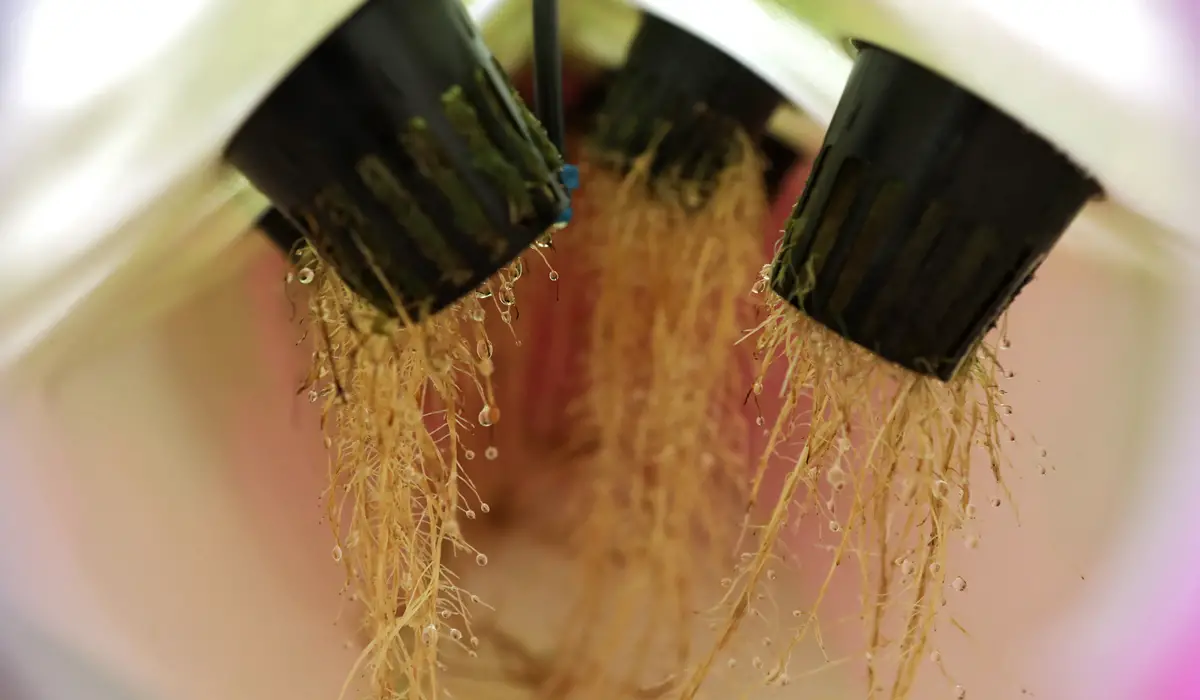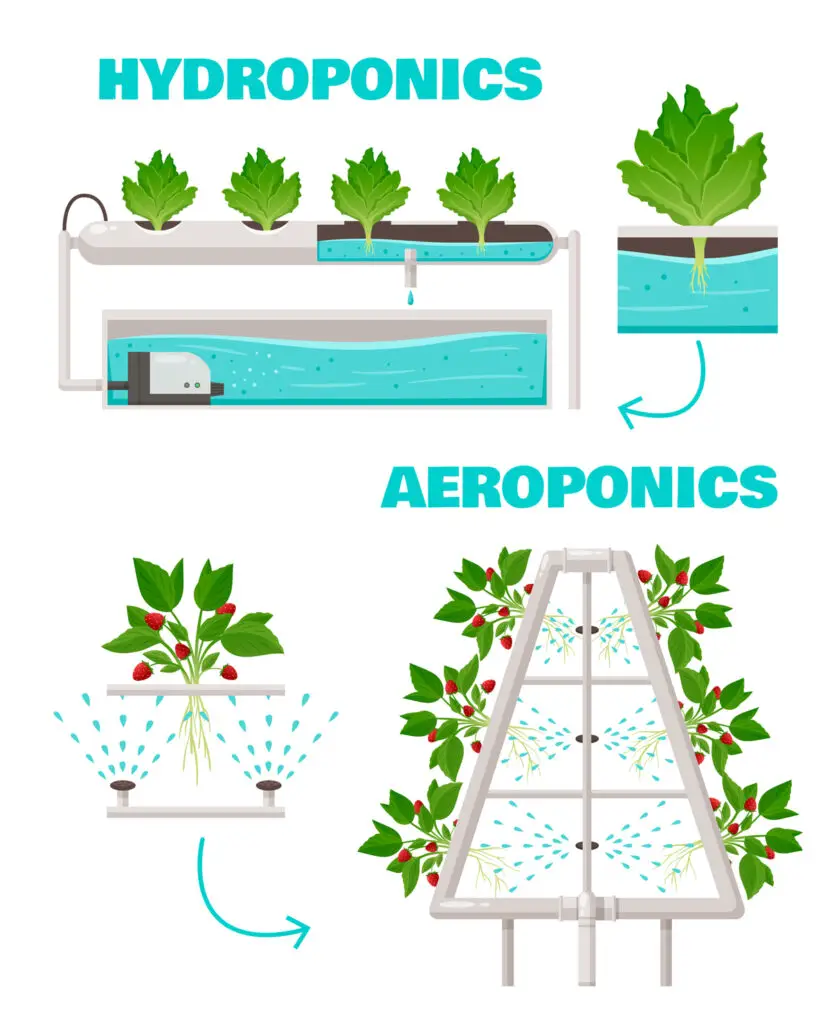Hydroponics vs. Aeroponics: Which one Reigns Supreme?

This post follows our research editorial guidelines.

It’s 2023 – a new year and a new opportunity for you to try out one of those hydroponic systems. Or, maybe it was an aeroponic system? You’re torn between the two. One is cheaper and easier to run, but the other produces larger-yield crops.
Which system is better? Honestly, it depends on what you’re looking to get out of it. Hydroponics are best used when growing leafy greens like lettuce, kale and spinach. I’ve also had incredible results growing peppers in deep water cultures. While Aeroponics are better suited to grow strawberries and tomatoes.

Table of Contents
If you have a lot of experience working with plants and want your plants to grow quickly, then the aeroponic system will be a better choice. However, if you want to have more control over the kind of nutrients your plant gets while simultaneously saving both space and water, then hydroponics is the clear winner.
Both growing systems have their pros and cons and that’s what I discuss below. As someone who’s used hydroponic and aeroponic systems, there are definite advantages to both, so deciding which one is right for you often comes down to personal preference as there are many differences between the two.
Also, if you want to get a jumpstart on your new system, you’ll also want to consider the best seeds for hydroponic gardening. Let’s get started.
Comparison Chart Aeroponics vs. Hydroponics
| Aeroponics | Hydroponics | |
| Complexity to setup | Expert | Beginner |
| Cost to maintain | Approx. $26 a month | 6-13% of initial setup cost |
| Cost to setup | $200-$1000 | $100-$1000 |
| Expected yield | 40% higher than soil | 20-25% higher than soil |
| Environmental impact | Reduces greenhouse gas emissions and eliminates herbicides and pesticides | Uses 10% less water than other methods |
| Nutrients Needed | 3.29% nitrogen, 0.44% magnesium, 0.43% calcium, 1.25% phosphorus, 2.46% potassium | 2.13% nitrogen, 0.40% magnesium, 0.32% calcium, 0.82% phosphorus, 1.81% potassium |
| PH Range | 5.5-6.5 | 6-6.5 |
What’s the Difference Between Hydroponics and Aeroponics?
While both methods can be used to grow big and healthy plants, hydroponics refers to the process in which plants’ roots are either fully submerged or intermittently submerged in nutrient-rich water, whereas aeroponics means that these nutrients are sprayed onto the plant’s roots.
All you have to do is lightly mist the root systems. This is the main difference between hydroponics and aeroponics, aside from the fact that they’re both more efficient than soil gardening.
Aeroponics
Aeroponics is a popular type of growing method in which plants are grown without soil in an enclosed environment. Aeroponic plants, when compared to other traditional methods or with hydroponics, tend to be fuller and have better color, taste, and texture.
Aeroponics offers plants that have a higher nutritional value, meaning that this method will offer the best results if you’re looking to keep a healthy diet.
Here are a few of the other advantages of aeroponic growing you should know if you’re considering running your own aeroponic garden:
Advantages of Aeroponic Growing

There are a ton of advantages that go along with aeroponic growth. First and foremost, aeroponic growing typically results in larger yields and faster overall plant growth while simultaneously using fewer resources than other growing methods.
Another big advantage of aeroponic growing is the fact that your plants’ roots always have sufficient oxygen exposure because they’re not submerged in water as would be required with a deep water culture.
“without a medium of soil to provide nutrients for the plant, growth is encouraged from the oxygen in the root zone.”
John Olson with Colby Community College in Northwest Kansas
He continues, “the aeration of the nutrient solution delivers an excessive amount of oxygen to the roots of the plant, reducing possibilities of disease and pathogen exposure.”
This is good news for anyone looking to grow their own lettuce after having heard horror stories about the massive amounts of bacteria found on the pre-cut and pre-packaged stuff.
Disadvantages of Aeroponic Growing
Of course, just like with any type of system, there are going to be drawbacks. And, ultimately, it’s going to be up to you as to whether an aeroponics system is going to be worth your time and energy.
This is mainly because the aeroponic system is more complex, especially for beginners. First and foremost, you have two options when it comes to having an aeroponic system. The first option is to build the aeroponic system yourself.
The supplies you’ll need include but aren’t limited to PVC tubing, a PVC connector, a 30-gallon tote and lid, a fountain pump, PVC primer, a drill, caulking gun, net pots, nozzle, and hose clamp. Depending on what supplies you already own or where you shop, it’s easy to keep these costs to a minimum.
However, the second option is when things get a bit more pricey. If you don’t want to build your own aeroponic system, you’ll have to go with one that’s already made, which can cost you well over $1,000.
As such, you must make sure this is a system you’re going to use because it’s quite an investment.
The other big disadvantage of an aeroponic growing system is that if a part stops working, it’s very easy for plants to die. And, unless you’re nearby when this happens, it can be impossible to prevent.
Furthermore, the use of this system requires a great deal of technical knowledge in terms of what kinds of nutrients your plant needs – and how often.
For example, plants in aeroponic systems need 0.44% of magnesium, 2.46% of phosphorus, and 3.29% of nitrogen (to name a few). While you can still have success with an aeroponic system if you’re just starting out, these are typically recommended for those who have already used a system like this.
Which Plants Grow Well in an Aeroponic Setup?

What makes an aeroponic setup so versatile is that you can grow just about any kind of plant you want in it.
Some of the best plants to grow in this kind of setup include a variety of vegetables including greens, tomatoes, strawberries, and even different kinds of herbs. You can also use an aeroponic setup to propagate tree whips and grow them to the desired size before planting them in soil.
Hydroponic
Hydroponics is a type of growing method. Hydroponic farming is a way to grow your plants in a soil-free environment while still providing them with the water and nutrients they need to grow. The idea with hydroponic plants is that you’re providing water and nutrients directly to the root, allowing the water to freely run off and prevent things like root rot.
Here are some of the advantages and disadvantages of using a hydroponic system.
Advantages of Hydroponic Growing
There are several excellent advantages to growing your plants in a hydroponic system. First off, they make very efficient use of water since all of the water is going directly to the root of the plant.
It also doesn’t consume as much space as growing everything in a garden. Because of how efficiently water and nutrients get to the root, plants that are grown hydroponically tend to grow faster and produce faster yields when compared to soil gardening.
If you’re planning on growing food, you can produce a higher quality crop due to the ability for everything to ripen on its own no matter what time of year it may be.They also don’t require as much involvement, so hydroponics saves you time.
Disadvantages of Hydroponic Growing
While hydroponic systems are a great way to grow plants, there are a few disadvantages of hydroponics you should keep in mind. Setups for hydroponics tend to be pretty pricey.
Since they’re so reliant on water being constantly pumped through the system, a power outage or malfunction can lead to killing your plants if you’re not able to save your setup in time.
They’re also more prone to waterborne diseases. Since the infection would gestate in the water first, you could potentially infect your entire crop and kill everything at once.
And, since these plants don’t have soil as a buffer to protect them from harm, your plants are more likely to be affected by problems a lot faster than a traditional soil setup.
Which Plants Grow Well in a Hydroponic Setup?

The answer: a lot, which is good news for you! Here is a list of the different types of hydroponic plants you can grow:
- Basil
- Mint
- Chives
- Cilantro
- Lettuce
- Tomatoes
- Spinach
- Kale
- Green beans
- Lima beans
- Cucumbers
- Blueberries
- Strawberries
- Hot peppers
- Radishes
Basically, anything that is small and pretty lightweight will grow in hydroponics. Hydroponics has a higher yield than soil gardening.
As such, you’ll want to avoid putting top-heavy crops such as cabbage, corn, potatoes, squash, and other larger root vegetables in a standard hydroponic system. These won’t grow well within the system.
Is Aeroponic More Expensive Than Hydroponic Growing?
One of the big differences between aeroponics vs hydroponics is cost. Generally speaking, growing your plants aeroponically is going to cost you more money than if you were to grow them through hydroponic methods. This has a lot to do with the cost of the supplies, maintenance, and setup.
For example, depending on the type of system you get, a home aeroponic system can cost anywhere from $400-$1,100. A home hydroponic system will cost anywhere from $50 to $1,000 depending on both size and brand.
Although aeroponics typically cost more, you’re going to have a lot of costs no matter which system you choose.
Do Plants Grow Faster in Aeroponic or Hydroponic Systems?
Plants typically grow faster in aeroponic systems because the nutrients are applied directly to the root. In other methods, the root has to search for nutrients. But with an aeroponics system, that isn’t the case.
Do Aeroponic Systems Increase Yields and Plant Growth?
Plant owners are concerned with growing their root system. Overall, aeroponic systems do increase both growth and yield.
In fact, according to a research study conducted by NASA, fruits, herbs, and vegetables grown in aeroponic farming systems grow at a rate that is three times faster when compared to those grown in soil.
Likewise, another survey from the University of Mississippi found that certain plants such as cherry tomatoes and bell peppers saw a 35% and 53% increase when grown aeroponically. These products thrive in aeroponics.
This isn’t to say, however, that plants raised hydroponically won’t see significant plant growth or offer large yields. Hydroponic plants tend to grow up to 50% faster than if they were planted in soil.
Other studies have found that farms that utilize the hydroponic method can grow approximately 240 times more crops than would be possible on a traditional farm.
However, if you’re just looking to grow and nurture your own plants at home, the aeroponic method will offer greater results.

Final Thoughts
There are a lot of similarities and differences between aeroponics and hydroponics. Aeroponics requires deep knowledge, whereas hydroponics farming requires more maintenance.
Deciding between a hydroponic system – like the Gardyn (check out this Gardyn Review), including cheap aeroponic kits or large-scale aeroponic systems, can be challenging because they both offer great benefits. Both systems allow great plant growth.
Hopefully, this list helps you weigh all the pros and cons so you can meet your plant-growing goals moving forward and decide between these two gardening methods and systems.
We welcome you to check out our blog for more information on the best aeroponic kits on the market.
